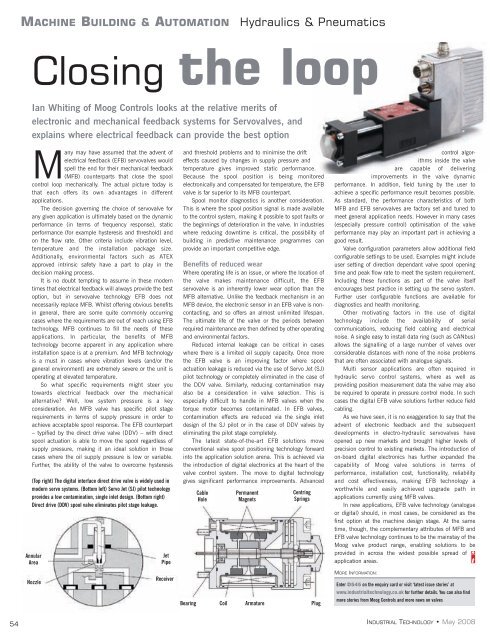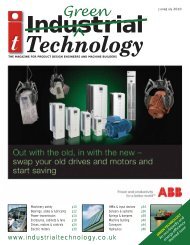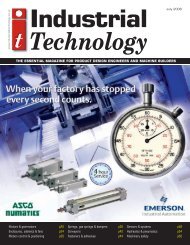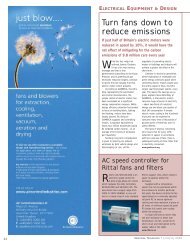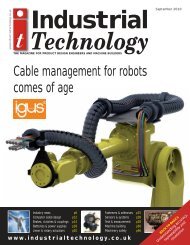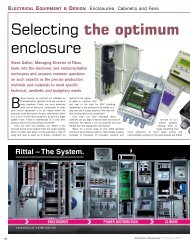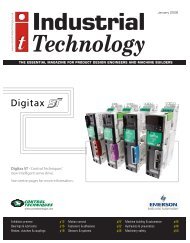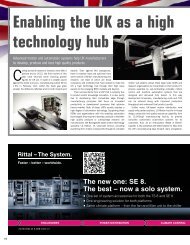sensors & systems - Industrial Technology Magazine
sensors & systems - Industrial Technology Magazine
sensors & systems - Industrial Technology Magazine
Create successful ePaper yourself
Turn your PDF publications into a flip-book with our unique Google optimized e-Paper software.
MACHINE BUILDING & AUTOMATION<br />
Hydraulics & Pneumatics<br />
Closing the loop<br />
Ian Whiting of Moog Controls looks at the relative merits of<br />
electronic and mechanical feedback <strong>systems</strong> for Servovalves, and<br />
explains where electrical feedback can provide the best option<br />
Many may have assumed that the advent of<br />
electrical feedback (EFB) servovalves would<br />
spell the end for their mechanical feedback<br />
(MFB) counterparts that close the spool<br />
control loop mechanically. The actual picture today is<br />
that each offers its own advantages in different<br />
applications.<br />
The decision governing the choice of servovalve for<br />
any given application is ultimately based on the dynamic<br />
performance (in terms of frequency response), static<br />
performance (for example hysteresis and threshold) and<br />
on the flow rate. Other criteria include vibration level,<br />
temperature and the installation package size.<br />
Additionally, environmental factors such as ATEX<br />
approved intrinsic safety have a part to play in the<br />
decision making process.<br />
It is no doubt tempting to assume in these modern<br />
times that electrical feedback will always provide the best<br />
option, but in servovalve technology EFB does not<br />
necessarily replace MFB. Whilst offering obvious benefits<br />
in general, there are some quite commonly occurring<br />
cases where the requirements are out of reach using EFB<br />
technology. MFB continues to fill the needs of these<br />
applications. In particular, the benefits of MFB<br />
technology become apparent in any application where<br />
installation space is at a premium. And MFB technology<br />
is a must in cases where vibration levels (and/or the<br />
general environment) are extremely severe or the unit is<br />
operating at elevated temperature.<br />
So what specific requirements might steer you<br />
towards electrical feedback over the mechanical<br />
alternative? Well, low system pressure is a key<br />
consideration. An MFB valve has specific pilot stage<br />
requirements in terms of supply pressure in order to<br />
achieve acceptable spool response. The EFB counterpart<br />
– typified by the direct drive valve (DDV) – with direct<br />
spool actuation is able to move the spool regardless of<br />
supply pressure, making it an ideal solution in those<br />
cases where the oil supply pressure is low or variable.<br />
Further, the ability of the valve to overcome hysteresis<br />
(Top right) The digital interface direct drive valve is widely used in<br />
modern servo <strong>systems</strong>. (Bottom left) Servo Jet (SJ) pilot technology<br />
provides a low contamination, single inlet design. (Bottom right)<br />
Direct drive (DDV) spool valve eliminates pilot stage leakage.<br />
Annular<br />
Area<br />
Nozzle<br />
Jet<br />
Pipe<br />
Receiver<br />
and threshold problems and to minimise the drift<br />
effects caused by changes in supply pressure and<br />
temperature gives improved static performance.<br />
Because the spool position is being monitored<br />
electronically and compensated for temperature, the EFB<br />
valve is far superior to its MFB counterpart.<br />
Spool monitor diagnostics is another consideration.<br />
This is where the spool position signal is made available<br />
to the control system, making it possible to spot faults or<br />
the beginnings of deterioration in the valve. In industries<br />
where reducing downtime is critical, the possibility of<br />
building in predictive maintenance programmes can<br />
provide an important competitive edge.<br />
Benefits of reduced wear<br />
Where operating life is an issue, or where the location of<br />
the valve makes maintenance difficult, the EFB<br />
servovalve is an inherently lower wear option than the<br />
MFB alternative. Unlike the feedback mechanism in an<br />
MFB device, the electronic sensor in an EFB valve is noncontacting,<br />
and so offers an almost unlimited lifespan.<br />
The ultimate life of the valve or the periods between<br />
required maintenance are then defined by other operating<br />
and environmental factors.<br />
Reduced internal leakage can be critical in cases<br />
where there is a limited oil supply capacity. Once more<br />
the EFB valve is an improving factor where spool<br />
actuation leakage is reduced via the use of Servo Jet (SJ)<br />
pilot technology or completely eliminated in the case of<br />
the DDV valve. Similarly, reducing contamination may<br />
also be a consideration in valve selection. This is<br />
especially difficult to handle in MFB valves when the<br />
torque motor becomes contaminated. In EFB valves,<br />
contamination effects are reduced via the single inlet<br />
design of the SJ pilot or in the case of DDV valves by<br />
eliminating the pilot stage completely.<br />
The latest state-of-the-art EFB solutions move<br />
conventional valve spool positioning technology forward<br />
into the application solution arena. This is achieved via<br />
the introduction of digital electronics at the heart of the<br />
valve control system. The move to digital technology<br />
gives significant performance improvements. Advanced<br />
Cable<br />
Hole<br />
Permanent<br />
Magnets<br />
Centring<br />
Springs<br />
Bearing Coil Armature Plug<br />
control algorithms<br />
inside the valve<br />
are capable of delivering<br />
improvements in the valve dynamic<br />
performance. In addition, field tuning by the user to<br />
achieve a specific performance result becomes possible.<br />
As standard, the performance characteristics of both<br />
MFB and EFB servovalves are factory set and tuned to<br />
meet general application needs. However in many cases<br />
(especially pressure control) optimisation of the valve<br />
performance may play an important part in achieving a<br />
good result.<br />
Valve configuration parameters allow additional field<br />
configurable settings to be used. Examples might include<br />
user setting of direction dependant valve spool opening<br />
time and peak flow rate to meet the system requirement.<br />
Including these functions as part of the valve itself<br />
encourages best practice in setting up the servo system.<br />
Further user configurable functions are available for<br />
diagnostics and health monitoring.<br />
Other motivating factors in the use of digital<br />
technology include the availability of serial<br />
communications, reducing field cabling and electrical<br />
noise. A single easy to install data ring (such as CANbus)<br />
allows the signalling of a large number of valves over<br />
considerable distances with none of the noise problems<br />
that are often associated with analogue signals.<br />
Multi sensor applications are often required in<br />
hydraulic servo control <strong>systems</strong>, where as well as<br />
providing position measurement data the valve may also<br />
be required to operate in pressure control mode. In such<br />
cases the digital EFB valve solutions further reduce field<br />
cabling.<br />
As we have seen, it is no exaggeration to say that the<br />
advent of electronic feedback and the subsequent<br />
developments in electro-hydraulic servovalves have<br />
opened up new markets and brought higher levels of<br />
precision control to existing markets. The introduction of<br />
on-board digital electronics has further expanded the<br />
capability of Moog valve solutions in terms of<br />
performance, installation cost, functionality, reliability<br />
and cost effectiveness, making EFB technology a<br />
worthwhile and easily achieved upgrade path in<br />
applications currently using MFB valves.<br />
In new applications, EFB valve technology (analogue<br />
or digital) should, in most cases, be considered as the<br />
first option at the machine design stage. At the same<br />
time, though, the complementary attributes of MFB and<br />
EFB valve technology continues to be the mainstay of the<br />
Moog valve product range, enabling solutions to be<br />
provided in across the widest possible spread of<br />
application areas.<br />
MORE INFORMATION:<br />
Enter D545 on the enquiry card or visit ‘latest issue stories’ at<br />
www.industrialtechnology.co.uk for further details. You can also find<br />
more stories from Moog Controls and more news on valves<br />
54<br />
INDUSTRIAL TECHNOLOGY • May 2008


